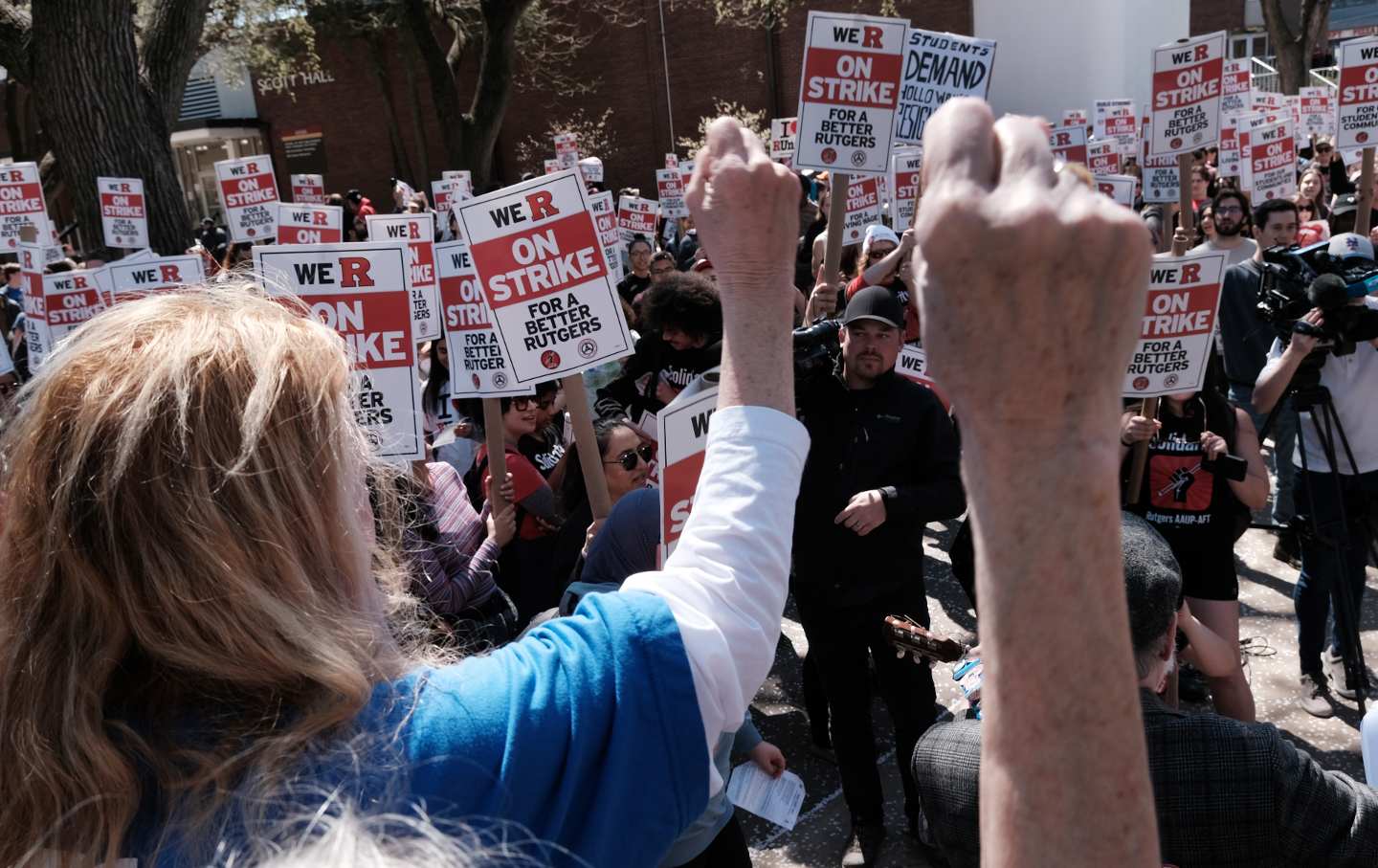
Rutgers students and faculty participate in a strike at the university’s main campus on April 10, 2023, in New Brunswick, N.J.(Spencer Platt / Getty Images)
Institutions of higher education in the United States are in crisis. Essential research is suffering. Highly qualified instructors lack job security and struggle to make ends meet. Students graduate saddled with debt. Public universities, the backbone of our system of higher education, have been starved of funding. Recently though, a ray of hope, in the form of a series of innovative strikes launched by segments of the higher education faculty at universities around the US, has emerged from the debacle. Most recently, last week’s tentative victory in a strike of the three faculty unions at Rutgers University in New Jersey has shown a way forward. At the three Rutgers campuses, graduate employees, adjunct instructors, non-tenure-track professors, tenured faculty, and others had been working without a contract since July 2022. Although represented by different unions, they faced down together the administration’s threats of court injunction to secure a victory against the short-term contracts and low wages that have long bedeviled American colleges and universities.
Public universities such as Rutgers have helped to make this country a powerhouse. The United States established publicly owned land-grant institutions of higher education in laws passed in 1862 and in 1890. These laws gave federally owned land to individual states as a means to raise money to establish such institutions. These colleges and universities were to focus on curricula devoted to cutting-edge practices of agriculture, science, and engineering. Though they were racially discriminatory, and their legacies often marred by expropriation of lands that had been Native American, their mandate was to benefit the people of their states through teaching, research, and service. Land-grant colleges and universities are by no means America’s only public institutions of higher education. State universities—formerly called teachers colleges—and community colleges have offered upward mobility to many. Together, these institutions have contributed mightily to the United States’ ascendence as an economic superpower with unparalleled levels of scientific research and technological innovation, while also offering upward mobility to millions.
The fabric of this national patchwork quilt of public higher education began to fray in the 1970s. Government anti-poverty and education programs of the 1960s helped many people. Black, Latin, LGBT, and female students gained new rights and new access to education and jobs, with much of their political activity taking place on campuses. Not surprisingly, a political backlash against education funding ensued. Free tuition in states such as California and Florida, as well as at City University of New York, came under attack. Funding declined. In 1969, over 75 percent of faculty were tenured or tenure track. By 2016, 73 percent of college instructors were not tenure track; instead most were low-paid, temporary employees. Tuition increased and student debt skyrocketed. Yet the number of administrators with six figure salaries also shot up.
Faculty activists have begun to fight back. In 2022, graduate employees at Indiana University struck for better pay and better work conditions. The successful strike of 48,000 graduate employees across the entire University of California University system and another at University of Illinois at Chicago rang in the year 2023. Grad employees at Temple University in Philadelphia followed with yet another successful walkout. Then at Rutgers, something new unfolded. While the prior strikes of university professors were mostly limited to one part of the professorate, Rutgers faculty prepared for their negotiations with the university’s administration by uniting the three unions representing the diverse sections of the academic workforce behind a single set of demands. In a labor action not focused on raising salaries of the privileged, strikers instead aimed to do what they could to ensure equal pay for equal work, measured by academic credit, among all sections of the faculty, and to end contingent labor among instructors.
On April 10, the three unions walked out as the only way to force the university to bargain. Reaching beyond the needs of their own ranks, they also struck for issues their students as well as the community at large would benefit from. They advocated, for example, a rent freeze on units owned by the university, because high rents were contributing to student indebtedness, and they demanded a million-dollar contribution to a Beloved Community Fund, to help the most vulnerable in their midst meet their needs. By emphasizing the common good, the strikers broadcast their intention to contribute to the reestablishment of a society that works for everyone. With this model of strike action, whole communities stand a chance of benefiting from labor’s struggle.
Often what strikers demand and what they win differ, but this time, the strikers arguably ran the table. They wrangled a 48 percent pay increase for adjunct faculty by 2025 and a 33 percent increase for graduate employees by 2025–26. They got presumptive renewal of contracts for nontenured professors, granting them a modicum of job security. Similar union victories elsewhere could help make contingent labor among faculty a thing of the past. They won $600,000 to be deposited in a common-good fund for the needy.
The strike has been suspended, but it has not ended. At the time of writing, the union representing biomedical and health science professions (the AAUP-BHSNJ) has yet to reach an agreement on their issues. Yet things look good. May these successes continue. Let us fully invest in the education side of the education business, for goodness sake. Fund those who may develop potentially world-saving scientific and technological inventions—or teach those who will. Recalling land-grant universities’ service mandate, let academic freedom and the unique political organizing opportunities offered on big campuses lead at revitalizing our decaying democratic institutions and help revitalize a society coming apart at the seams.
Jonathan DavidJonathan David is a folklorist, writer, and former adjunct instructor who lives in Philadelphia.